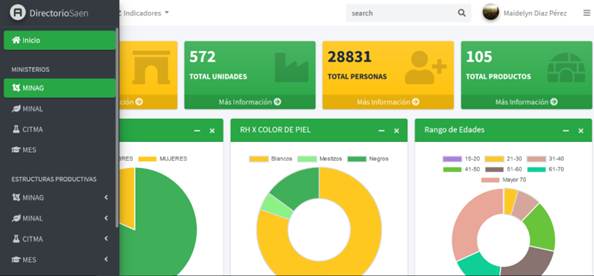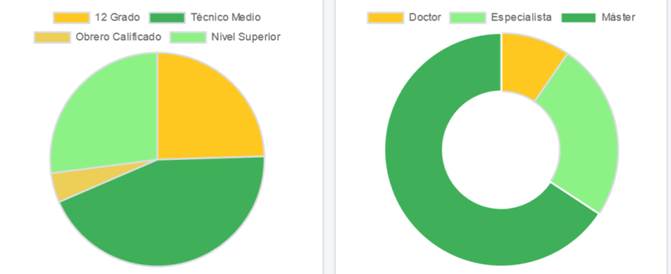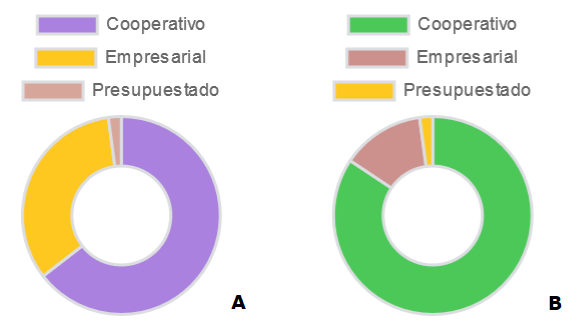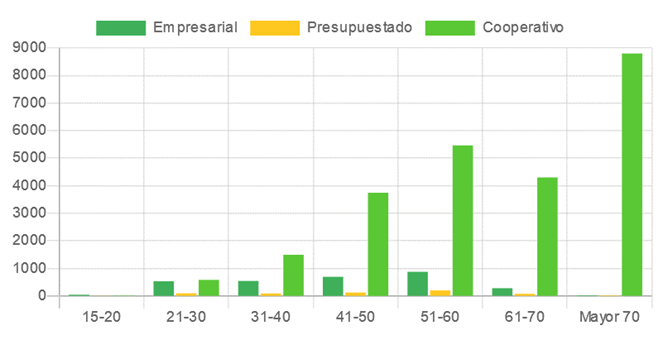Meu SciELO
Serviços Personalizados
Artigo
Indicadores
-
 Citado por SciELO
Citado por SciELO
Links relacionados
-
 Similares em
SciELO
Similares em
SciELO
Compartilhar
Cooperativismo y Desarrollo
versão On-line ISSN 2310-340X
Coodes vol.10 no.1 Pinar del Río jan.-abr. 2022 Epub 30-Abr-2022
Original article
Information management system of actors and sectors in food production in Pinar del Río
1 Universidad de Pinar del Río "Hermanos Saíz Montes de Oca". Editorial Universitaria. Pinar del Río, Cuba.
The automated and integrated management of the social and human dimension of the different sectors involved in food production in Cuba is one of the dimensions of work that needs to strengthen the plan for food sovereignty of the nation. There is an urgent need to better manage the technical and qualified force available to coherently promote the different programs prioritized for food production in each territory. Given this need, the present research aims to show the potential use of the Directory of Actors and Sectors of the Food Sovereignty Observatory as a system that manages information on human resources by ministries related to food production and science in Pinar del Río. The research used different methods and procedures that allowed obtaining as a result a system that compiles information by ministries, productive structures, units and human resources and also describes their dynamics by different variables such as age, sex, skin color, schooling level, scientific category, among other aspects. This system allows for a more comprehensive knowledge of productive capacities, based on the mapping of resources and structures involved in food production in the province.
Key words: information systems; system interoperability; comprehensive management; food sovereignty; human resources; productive structures
Introduction
Montoya Agudelo and Boyero Saavedra (2016, p. 2) stated: "today, the challenge faced by the leaders of organizations is based, among other aspects, on the management of their human resources towards a work aimed at achieving efficacy and efficiency, in order to achieve high standards of performance based on added value and a significant competitive advantage".
Cuesta Santos et al. (2018) have approached human talent management from the field of human resources management. Their objective being the needs of the enterprise, for the improvement of human capital in the short, medium and long term, taking into consideration the existing potential in the organization's positions (Armijos Mayon et al., 2019).
Human resources management plays a fundamental role in achieving this purpose; that is why organizations are increasingly interested in knowing what motivates their employees, what their labor potential is and what training and competence requirements they have to meet (Pía Hernando, 2007).
For this reason, the country´s top leadership has a special interest in the food production sector, as it is one of the most sensitive strategic sectors in this regard, and there is a marked interest in the adequate and comprehensive management of its human and structural capital.
The management of human resources is increasingly dependent on the capacity of articulation between technological systems, mainly the New Information and Communication Technologies (Cuesta Santos, 2010). In this regard, the use of Information and Telecommunication Technologies is one of the most expeditious ways to achieve the development of information systems that manage the organization's human resources in a way that is more relevant to its vision and goals, not only to its functions.
Adequate computing management makes it possible to simplify, homogenize and improve an organization's information and documentation flows; to optimize human resources in terms of effort and tasks, and to improve the functioning of other resources by facilitating decision making and the ability of organizations to react according to their priorities, needs and the demands of their environment.
Information systems have an enormous importance in increasing organizational capacity. Any institution that needs to achieve high levels of efficiency and efficacy in the management of its main processes and substantive functions should consider the use of an information and knowledge management system tailored to the organization, which allows them to document their processes, make functions and structures compatible, socialize actions, and so on (Díaz Pérez, 2017).
However, although it is evident all the advantages of the comprehensive and interoperable management of the different systems that manage human resources, there is still no consensus on its development. In the country, for example, in the food production sector, the ways in which human resources are managed by productive structures must be adapted in a more accurate way, since many decisions that directly affect a greater or lesser food production will depend on their proper articulation and management.
Correspondingly, the country's top leadership, together with several national researchers, formed a working system for the Food Sovereignty and Nutrition Education Plan (Minag, 2020). From this plan, the action of "creating the Technological Observatory on the management of Local Food Systems and its connection with other info technological platforms at different scales, as a priority with the government network and the Ministry of Agriculture" is derived (Díaz-Canel Bermúdez et al., 2020).
Given this need and based on the guidelines issued by the President of the country regarding the need to work on the social and human dimension of the nation's Food Sovereignty and Nutrition Education Plan (SAEN in Spanish), this research aims to show the potential use of the Directory of Actors and Sectors (Directorio SAM Pinar in Spanish) of the Observatory of Food Sovereignty and Nutrition Education of Pinar del Río as a system that manages information on actors (human resources) and sectors (ministries and productive structures) involved in food production in the province of Pinar del Río.
Materials and methods
As a theoretical level method, the historical-logical method was used to work on the information corresponding to each productive structure by ministries in the province, as well as the analysis and synthesis to delimit the different analyses required in each structure (administrative, cooperative and production sectors, as well as the business sector). Modeling was applied for the design of the system's information architecture, its information and process flows, as well as for the design of the software engineering of the Directorate's computer system. In addition to using the structural systemic method for the harmonic combination of sources and structures, with the different variables of analysis.
Results and discussion
The SAM Pinar Directory is part of the technological platform managed by the Food Sovereignty and Nutrition Education Observatory (SAEN+C Observatory) of Pinar del Río (Díaz Pérez, 2020; Díaz Pérez et al., 2021), as part of the Food Sovereignty and Nutrition Education Plan of the country. The home page of the SAEN+C Pinar Observatory (Fig. 1) allows access to the SAM Pinar Directory from its top menu.
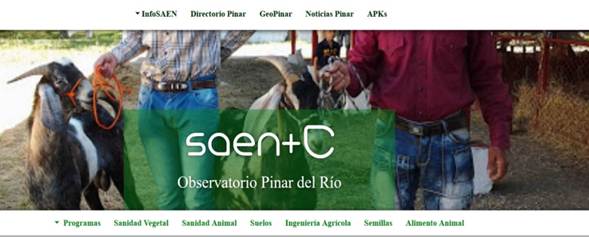 Source: SAEN+C Pinar Observatory
Source: SAEN+C Pinar ObservatoryFig. 1 Observatory of Food Sovereignty and Nutrition Education with more Science of Pinar del Río
The SAM Pinar del Río Directory on its home page groups the main ministries, structures and units of the different sectors involved in food production in Pinar del Río. At this stage, it was worked only with the Ministry of Agriculture (Minag), the Ministry of Food, the Ministry of Science, Technology, Innovation and Environment and the Ministry of Higher Education (Fig. 2).
This research uses Minag as a case study to show the potential of using this system.
The SAM Pinar Directory has so far registered 27 enterprises in the sector in the province. The 11 municipal sub-delegations that methodologically direct the activity, those that enforce together with the territorial delegation the state order of the country. From the cooperative sector, it has registered 572 productive units, introduced at this stage, together with a total of 28,831 people registered throughout the province working in 105 types of products.
At Minag, the highest percentage of human resources is male, white-skinned and between 31 and 40 years of age (Fig. 2).
The analysis of human resources by level of schooling shows that in the agricultural sector there is a higher proportion of technicians compared to people with higher education and qualified workers (Fig. 3). The greatest presence of people with a master's degree is found in people between 61 and 70 years of age, followed by specialists between 51 and 60 years of age and, to a lesser extent, doctors of science between 31 and 40 years of age.
The behavior of schooling by sex is representative, to a certain extent, of the characteristics of this sector (Fig. 4). There are approximately the same number of men and women who are middle-level technicians and higher-level technicians, with a greater number of men in the remaining levels of schooling.
However, there is a greater presence of women as specialists in the sector, as well as scientific interest in doctoral and master's degree research, although for the moment men outnumber them (Fig. 4).
The possibility of having a system that calculates the characteristics of the human resources of an entire ministry, by level of schooling and scientific categories, is a high value-added service with a significant use value to support a wide variety of decisions. This information makes it possible to characterize the scientific and technological competencies of the agricultural sector in the province, as well as to identify the main strengths and weaknesses in research.
From another dimension, the SAM Pinar Directory also allows to analyze human resources by productive structures within the Minag. This ministry has three sectors: budget sector (territorial delegation plus the eleven municipal sub-delegations), business sector (27 enterprises and 191 units) and cooperative sector (369 production units and associates) (Fig. 5A).
The distribution of human resources by sector (Fig. 5B) is as follows. The budgeted sector has a total of 619 people. The business sector has 3910 people employed to carry out its functions. In the cooperative sector, approximately 24,397 people are employed in the sowing plans. This behavior is the most dynamic within the sector, so it is more difficult to be precise, but even so, this system can be used to identify the human resources that have been hired by the different cooperatives and associated units.
The possibility of knowing the human resources available in each structure allows for the integrated management of the Minag's human capital, based on the priorities of the State, the government in the territories and in each locality, and the fulfillment of its functions, objectives and planned goals.
Another dimension of analysis that is of special interest in the Cuban case is the behavior of population dynamics in the agricultural sector. In this regard, the SAM Pinar Directory allows the monitoring of human resources by age in each structure. At this stage of development, the system warns about the aging of the productive force in the agricultural sector in Pinar del Río (Fig. 6), mainly in the cooperative sector.
This analysis constitutes a red alert on the urgent need for the cooperative sector to mobilize a young technical, specialized and productive workforce. It is urgent to make a more proactive management of the composition of its workforce, working on its projection in collaboration with other instances and actors of the territory.
It is estimated that the aging dynamics of Minag in general constitute the most real, predictable and tangible threat to food production in the province today.
It is necessary to anticipate the solution of possible adverse scenarios in food production in view of the sustained lack of young human resources directly linked to the productive activity required in the province.
This sector foresees signs of an aging economy where the time will come when services and products for the elderly will surpass those consumed by the young, a situation that threatens the food sovereignty of the province and even becomes a strategic issue because aging is a national security issue.
From another point of view, this system, as part of its functions, allows for monitoring, surveillance and analysis of human resources at different levels of segregation of productive structures.
The SAM Pinar Directory also makes it possible to monitor the units by enterprise, offering detailed information on the profile and technical data of each enterprise, together with the characteristics of its human resources, thus fulfilling its functions as a directory.
The SAM Pinar Directory contains the human and structural capital of the main ministries related to food production in the province, responding to one of the demands and orientations of the President of the Republic as part of the SAEN Plan in Cuba. Therefore, it constitutes one of the priorities of the SAEN+C Pinar Observatory to comply with a precise orientation of the highest leadership of the country.
This system has different services that offer the possibility of observing and establishing a follow-up of the human resources of the different facilities, structures and productive capacities of the province through an interoperable information management system, which is managed by the University of Pinar del Río in the territory.
Having a system that manages the different production units and structures for each ministry involved in the promotion and strengthening of food production in the territory is a strength of innumerable value for practical and analytical use that allows supporting decision making in the construction of policies, strategies and action plans in the organization of activities, as well as the control and evaluation of their results from the social and human dimension of work.
Referencias bibliográficas
Armijos Mayon, F. B., Bermúdez Burgos, A. I., & Mora Sánchez, N. V. (2019). Gestión de administración de los recursos humanos. Universidad y Sociedad, 11(4), 163-170. https://rus.ucf.edu.cu/index.php/rus/article/view/1295 [ Links ]
Cuesta Santos, A. (2010). Tecnología de gestión de recursos humanos (3.a ed.). Félix Varela. [ Links ]
Cuesta Santos, A., Fleitas-Triana, S., García Fenton, V., Hernández Darias, I., Anchundia-Loor, A., & Mateus Mateus, L. (2018). Evaluación del desempeño, compromiso y gestión de recursos humanos en la empresa. Ingeniería Industrial, 39(1), 24-35. https://rii.cujae.edu.cu/index.php/revistaind/article/view/861 [ Links ]
Díaz Pérez, M. (2017). Sistemas de gestión de información y conocimiento en empresas cooperativas: Sociedades colaborativas de conocimiento. Cooperativismo y Desarrollo, 5(2), 221-232. https://coodes.upr.edu.cu/index.php/coodes/article/view/178 [ Links ]
Díaz Pérez, M. (2020). La Soberanía Alimentaria y Nutricional desde la perspectiva de un Observatorio Territorial. Cooperativismo y Desarrollo, 8(3), 466-477. https://coodes.upr.edu.cu/index.php/coodes/article/view/393 [ Links ]
Díaz Pérez, M., Triana Velázquez, Y., Brizuela Chirino, P. R., Rodríguez Font, R. J., Giráldez Reyes, R., & Blanco Borrego, J. (2021). Soberanía Alimentaria y Educación Nutricional desde la ciencia de la sostenibilidad: Observatorio SAEN+C Pinar. Universidad y Sociedad, 13(5), 9-19. https://rus.ucf.edu.cu/index.php/rus/article/view/2206 [ Links ]
Díaz-Canel Bermúdez, M., Núñez Jover, J., & Torres Paez, C. C. (2020). Ciencia e innovación como pilar de la gestión de gobierno: Un camino hacia los sistemas alimentarios locales. Cooperativismo y Desarrollo, 8(3), 367-387. https://coodes.upr.edu.cu/index.php/coodes/article/view/372 [ Links ]
Minag. (2020). Plan de soberanía alimentaria y educación nutricional de Cuba. Ministerio de la Agricultura. https://www.minag.gob.cu/sites/default/files/noticias/documentos_complementarios.rar [ Links ]
Montoya Agudelo, C. A., & Boyero Saavedra, M. R. (2016). El recurso humano como elemento fundamental para la gestión de calidad y la competitividad organizacional. Revista Científica Visión de Futuro, 20(2), 21-37. https://visiondefuturo.fce.unam.edu.ar/index.php/visiondefuturo/article/view/65 [ Links ]
Pía Hernando, M. (2007). Las buenas prácticas en la gestión de recursos humanos en las organizaciones de Mar del Plata. Universidad Nacional de Mar del Plata. http://nulan.mdp.edu.ar/657/ [ Links ]
Received: April 06, 2022; Accepted: April 22, 2022











 texto em
texto em 

